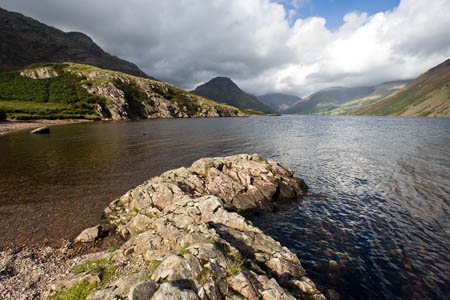The whole of the western Lake District would be suitable for burying radioactive waste, according to a study released today.
A scientific report examining the geology of the area only rules out an area west of the Lake District, running from St Bees Head on the coast, up to the Solway Firth.
The rest of the area, covered by Allerdale and Copeland Councils, should not be ruled out for waste burial.
Both authorities, along with Cumbria County Council, expressed an interest in a Government search for potential sites. The study, by the British Geological Survey, was undertaken to see if any areas should be ruled out of bounds for radioactive disposal and its authors stressed it did not necessarily mean facilities would be eventually sited there.
The north-western corner of Cumbria was ruled out because of the risk of future generations mining for ore in the area. Some nuclear waste, such as plutonium-239 produced during the nuclear fission at the heart of reactors, will be dangerous to humans and animals for more than 100,000 years.
West Cumbria is already heavily dependent on the nuclear industry with at least 10,000 jobs dependent on the Sellafield facility on the coast and its ancillary sites.
The Allerdale and Copeland areas cover Wast Water, Buttermere, Bassenthwaite Lake, Derwent Water and Thirlmere.
The coalition Government welcomed the report. Minister of State for Energy Charles Hendry said: “We must progress implementation of geological disposal, the long-term sustainable solution for dealing with radioactive waste.
“Today’s report, commissioned from the British Geological Survey, is a step forward. The geological disposal facility site selection process is based on voluntarism and partnership and these results do not present any reason why west Cumbria cannot continue to consider whether or not to participate in that process.”
The Department of Energy and Climate Change said if a community chooses to proceed further, increasingly detailed geological and other criteria assessment would have to be undertaken.
The work is part of the Government’s managing radioactive waste safely programme and the process for communities across the country to find out more about the siting procedure remains open.
But Ben Ayliffe, senior energy campaigner at Greenpeace, told said: “This report means that almost anywhere in the Lake District could become a dump for the UK’s radioactive waste.
“It’s hard to imagine a more tragic legacy to Britain’s nuclear folly than vats of lethal nuclear waste being stored around Keswick or Scafell Pike. It’s certainly not the sweeping vistas that would have inspired Wordsworth or Coleridge.
“And dumping this stuff underground is no solution anyway, wherever it is. So we certainly shouldn’t be creating any more nuclear waste. There are much better ways of producing electricity,” he added.

Jon
29 October 2010It's a pity Ben Ayliffe can't resist making unsupported comments and specious remarks. There may well be good reasons not to bury nuclear waste under west Cumbria, in which case it would be good to hear them.
What is not helpful or relevant is talking about "vats of lethal nuclear waste being stored around Keswick or Scafell Pike" which no-one is suggesting. Invoking Wordsworth and Coleridge to defend the Lakes from imaginary blots on the landscape (and "lethal" ones at that) is lazy and tendentious. If Ben happens to read this, perhaps he would like to explain his remarks. I don't suppose nuclear waste can be buried without any landscape implications; wouldn't it be better to campaign for protection of the landscape from the mining equipment, tracks and spoil heaps that would presumably be needed? But that wouldn't allow Ben to get in his emotional digs at the power source he hates.
Why is "dumping this stuff underground" no solution anyway? The radioactive fuel for nuclear power stations is mined from underground - burying the waste in those mines is not desirable because of the transport costs and risks, but burying it deep down in geologically stable areas relatively close to existing nuclear power stations is the best anyone has suggested yet. If Greenpeace have a better idea can they please promote it.
And what are the "much better ways of producing electricity"? A few million wind turbines and a backup coal-fired power station?
Gerald Daly
30 October 2010The Manhattan Project which developed the atom bomb cost, at the time, in excess of two billion dollars. Robert Oppenheimer who led the team said after the first test, "I am become death, the destroyer of worlds". Several other members of the team signed petitions against 'loosing the monster they had created' but to no avail and we all know what happened next. Robert Lewis, a pilot on the Enola Gay said in horror "My God, what have we done?".
Eventually nuclear explosions were controlled - sort of - and we ended up with the proliferation of nuclear power reactors not to mention nuclear powered surface ships and submarines. Each and every reactor is a nuclear device awaiting human error or even sabotage to detonate it or to cause a leakage of radioactive pollution. Chernobyl is probably the prime example of a nuclear accident which brought untold suffering, not only to the present generation, but generations to come by way of disfigurement etc and laid waste vast tracts of land which will be unuseable far into the future. Has human pride no bounds? Does human kind learn nothing from history? Accidents will happen and carnage will follow. It has happened in the past and will happen again. I would suggest that the 'experts' apply their own energies more efficiently by converting two billion wartime dollars to present day values and investing it in the development of 'green' energy instead of burying their heads as well as their nuclear waste in the sand.